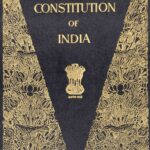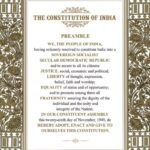Biography of the Constitution of India
Name: Constitution of India
Date of Birth: 26th November 1949 (adopted)
Date of Coming of Age: 26th January 1950 (enforced, Republic Day)
Place of Origin: Constituent Assembly of India, New Delhi
Father Figures: Dr. B.R. Ambedkar (Chairman of the Drafting Committee), Members of the Constituent Assembly
Nationality: Indian
Occupation: Supreme Law of the Land
Early Life (Background and Formation)
The Constitution of India was born out of the struggle for independence from British colonial rule. Before its “birth,” India was governed under the Government of India Act, 1935, which was insufficient for a free and diverse nation.
In 1946, the Constituent Assembly was formed to draft a document that would define the destiny of a free India. The Assembly consisted of 389 members (later 299 after partition) representing all regions, religions, and communities of India.
Dr. B.R. Ambedkar, known as the Father of the Indian Constitution, played a pivotal role as Chairman of the Drafting Committee, shaping the Constitution into a framework that balances rights, duties, justice, and governance.
Coming of Age (Adoption and Enforcement)
Adoption: On 26th November 1949, the Constitution was officially adopted by the Constituent Assembly after extensive debates, reflecting the voice of the Indian people.
Enforcement: The Constitution came into force on 26th January 1950, marking India’s Republic Day. This date was chosen to honor the Purna Swaraj Declaration of 1930, symbolizing full independence.
Personality and Character Traits
The Constitution of India is unique and multifaceted, combining strength with flexibility:
Sovereign and Independent: Respects the authority of the Indian nation.
Democratic: Emphasizes the power of the people to govern.
Secular: Maintains equality of all religions.
Socially Conscious: Advocates justice, equality, and welfare.
Adaptable: Can be amended to suit changing needs while preserving core principles.
Protector of Rights: Upholds civil liberties, fundamental rights, and the rule of law.
Major Life Achievements
Longest Written Constitution in the World: 448 articles, 12 schedules, and 104 amendments (as of 2020s).
Foundation of Republic: Ensures that India is a sovereign, socialist, secular, and democratic republic.
Balance of Power: Establishes a federal system with a unitary bias and an independent judiciary.
Rights and Duties: Grants fundamental rights and outlines citizens’ duties.
Guidance for Governance: Provides Directive Principles of State Policy for socio-economic development.
Milestones
1946: Constituent Assembly formed.
1947: India gains independence from British rule.
26th November 1949: Constitution adopted.
26th January 1950: Constitution comes into force.
42nd Amendment (1976): Strengthened Parliament’s powers.
44th Amendment (1978): Restored civil liberties.
101st Amendment (2016): Introduced GST and economic reforms.
Legacy and Influence
Guardian of Democracy: The Constitution is the supreme authority, ensuring India’s democratic structure.
Social Reformer: Promotes equality, justice, and protection for marginalized communities.
Living Document: Continues to evolve through amendments, balancing tradition with modern needs.
Global Recognition: Serves as a model for emerging democracies around the world.
Conclusion
The Constitution of India is more than just a legal document; it is a living personality that safeguards the dreams and rights of over 1.4 billion citizens. It is a wise, patient, and just entity, guiding the nation toward unity, democracy, and prosperity. Like a guardian, teacher, and parent rolled into one, it continues to inspire generations, reminding everyone of India’s sacred values and democratic ideals.








